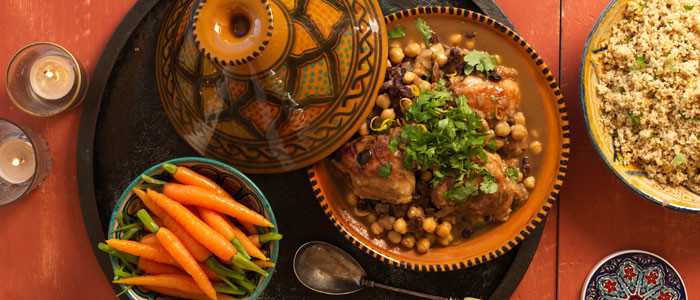One of the most popular exports from Morocco is their world-famous dates. They export more than 90,000 tons of them each year to locations around the globe. Dates have played an important part in Moroccan cuisine for thousands of years. Archaeological evidence suggests the cultivation of dates all the way back in 6,000 BC in Arabia. The date palm was a major source of life for thousands of people throughout the Middle East and Northern Africa and is said to have provided people with thousands of different uses including thread, mattresses, lumber, rope, and many other household and dietary uses. Dates are also very important in Islam with the date palm regarded as the "tree of life" as mentioned in the Story of Genesis and also eaten to ceremoniously break fast during Ramadan.
摩洛哥最受欢迎的出口产品之一是该国举世闻名的枣子。摩洛哥每年向全球各地出口超过9万吨枣子。数千年来,枣子在摩洛哥美食中发挥着重要作用。考古证据表明,公元前6000年,阿拉伯半岛就有人种植枣树。枣树是许多中东人和北非人的主要生活来源,据说,它有上千种不同的用途,可以做成线、床垫、木材、绳子,还有许多家庭和饮食方面的其他用途。枣子在伊斯兰教中也是很重要的,《创 世纪》中曾提到,枣树被视为“生命之树”,而且在斋月期间,人们还会在正式的开斋仪式上吃枣子。
In the Valley of Roses, local legend states that pilgrims returning from Mecca brought with them the "Mother of all flowers," the Damascus rose, initiating the rose industry in Morocco. In 1912, French parfumiers realized that the Vallee des Roses would be an ideal place to mass cultivate the bushy Rosa centifolia. Today, there are hundreds of kilometers of rose bush hedges and two factories in the valley, distilling rose essence.
玫瑰谷当地的传说是这样写的:从麦加朝圣归来的人带来了“万花之母”大马士革玫瑰,由此开创了摩洛哥的玫瑰产业。1912年法国的花匠们意识到,玫瑰谷将是大规模密集种植千叶蔷薇(摩洛哥玫瑰)的理想之地。如今这里有数百公里长的玫瑰灌木树篱,山谷里还有两家提炼玫瑰精华的工厂。
Morocco is one of the world's largest producers of illicit hashish. One of the major sources of income for families in Morocco's Northern Rif region is cannabis (marijuana) cultivation. In fact, the word "reefer" derives from the word rif. The cannabis, known in Arabic as kif, is then processed and sold as hashish.
摩洛哥是世界上最大的非法大麻麻醉剂的生产国之一。生活在摩洛哥北部里弗(Rif)地区的家庭,其主要收入来源之一就是种植大麻。事实上,“reefer”(大麻香烟)这个词来源于rif这个词。在阿拉伯语中,大麻又被称为kif。然后,大麻被加工成大麻制剂并出售。
Moroccan Berber women still have tattoos in geometric designs on their faces, sometimes covering much of their forehead, cheeks, and necks. These are marks of tribal identification and date from a time when it was necessary to be able to spot women of one's tribe who had been carried off in raids.
摩洛哥柏柏尔族女性的脸上仍然有几何图案的文身,有时这种文身会覆盖她们的前额、脸颊和脖子的大部分。这些是部落身份的标志,它可追溯至需要能认出在突袭中被掳走的部落女性的时代。
White is the color of mourning in Morocco. A Moroccan widow wears white for 40 days after the death of her husband.
摩洛哥的丧服是白色的。一名摩洛哥寡妇在其丈夫死后的40天里都要穿白色的衣服。

Dubbed Moroccan, or Berber, "whiskey," tea has become the national drink of Morocco. It was introduced to Morocco in 1854 when blockaded British merchants unloaded large quantities of tea at major Moroccan ports, The a la Menthe (Green Mint Tea) is Chinese green tea brewed with a handful of mint leaves and liberally loaded up with sugar.
茶已成为摩洛哥的国民饮品,它又被称为摩洛哥或柏柏尔“威士忌”。茶于1854年被引入摩洛哥,当时被困住的英国商人在摩洛哥的主要港口抛售了大量茶叶。The a la Menthe(绿薄荷茶)是用少量薄荷叶沏成的中国绿茶,还会加很多糖。
Couscous is said to be the national dish of Morocco. It is prepared weekly in many Moroccan homes and the presentation pictured here, couscous with seven vegetables, is one of the most popular versions. Lamb, beef or chicken is stewed along with a variety of vegetables then arranged on a glorious heap of tender, steamed couscous grains. As with many other Moroccan dishes, everyone gathers round to eat from one super-sized communal plate.
据说,蒸粗麦粉是摩洛哥的国菜。在许多摩洛哥家庭里,每周都要做这道菜,图中所示的是最受欢迎的版本之一:七菜蒸粗麦粉。把羊肉、牛肉或鸡肉与各种蔬菜炖在一起,然后放在鲜美的蒸粗麦粉上。就像其他许多种摩洛哥菜一样,所有人聚在一起共享一个超大的盘子上的美食。
A visit to Morocco without sampling at least one tagine would be a crime. The word tagine refers to both the conical-shaped dish and the steaming food that's cooked inside it – usually a blend of tasty sweet and savoury flavours. With each region offering a different take on the recipe, you'll find anything from a kefta tagine, olive tagine, vegetable tagine and of course, the ever-popular lemon and chicken tagine is a must. A tagine every damn day? Yes. Yes. And more yes!
如果你去了摩洛哥却没有尝一下塔吉锅炖菜,那就太令人遗憾了。“Tagine”这个词既指圆锥形的锅,也指在其中蒸熟的食物——通常是香甜可口的美味。每个地区都有不同的菜谱,你会发现各种塔吉锅炖菜,有肉丸、橄榄、蔬菜,当然一定有备受欢迎的柠檬和鸡肉。每天都吃塔吉锅炖菜吗?是的。我很确定!
Forget about your fave smashed avo and eggs at your local cafe – berber omelette might just change your life. Served and cooked in a tagine, this little guy will make you one happy traveller. Infused with every spice under the sun, tomatoes and mixed veg, this is a true winner.
忘掉你在当地咖啡馆吃到的碎鸡蛋吧——柏柏尔蛋饼可能会改变你的生活。这道菜是用塔吉锅烹饪并盛放的,这道小吃会让你成为一个快乐的旅行者。加入各种晒好的香料、西红柿和混合蔬菜就更美味了。
The name of Jemaa el Fna, the vast market square in Marrakech, Morocco, literally means "assembly of the dead" and may refer to the traditional display of the heads of criminals executed there until the 19th century.
摩洛哥马拉喀什市有一个巨大的集市广场。这个广场的名字是Jemaa el Fna,字面意思就是“亡者集会”,这可能是因为19世纪之前通常会在这里摆放被处决的罪犯的头颅。
The Hassan II Mosque in Casablanca is the world's seventh largest mosque and took five years of intensive labor by over 30,000 workers and craftsman to complete in 1993. The mosque's minaret at 689 feet (210 m) high is the world's tallest, and it is Casablanca's chief landmark. In terms of covered area, the Hassan II Mosque is the largest in the world and has space for 80,000 worshippers.
位于卡萨布兰卡的哈桑二世清真寺是世界第七大清真寺,它是由3万多名工人和工匠经过5年时间的努力,最终于1993年建成的。这座清真寺的尖塔是世界上最高的,高达689英尺(210米),它也是卡萨布兰卡最重要的地标。就占地面积而言,哈桑二世清真寺是世界上最大的清真寺,可容纳8万名朝拜者。













